Mushroom hunting can require some keen observation skills and experience. Fortunately, There are a few unique looking mushrooms that even a beginner should be able to safely identify with a little effort. However, some of the ones below have toxic look-alike’s which I did not mention. Each of the mushrooms below should really be researched individually to get a good picture of what is safe and what is not. Using multiple references to verify the information is considered a best practice in mushroom hunting. With that caveat behind us, lets go!
Morels
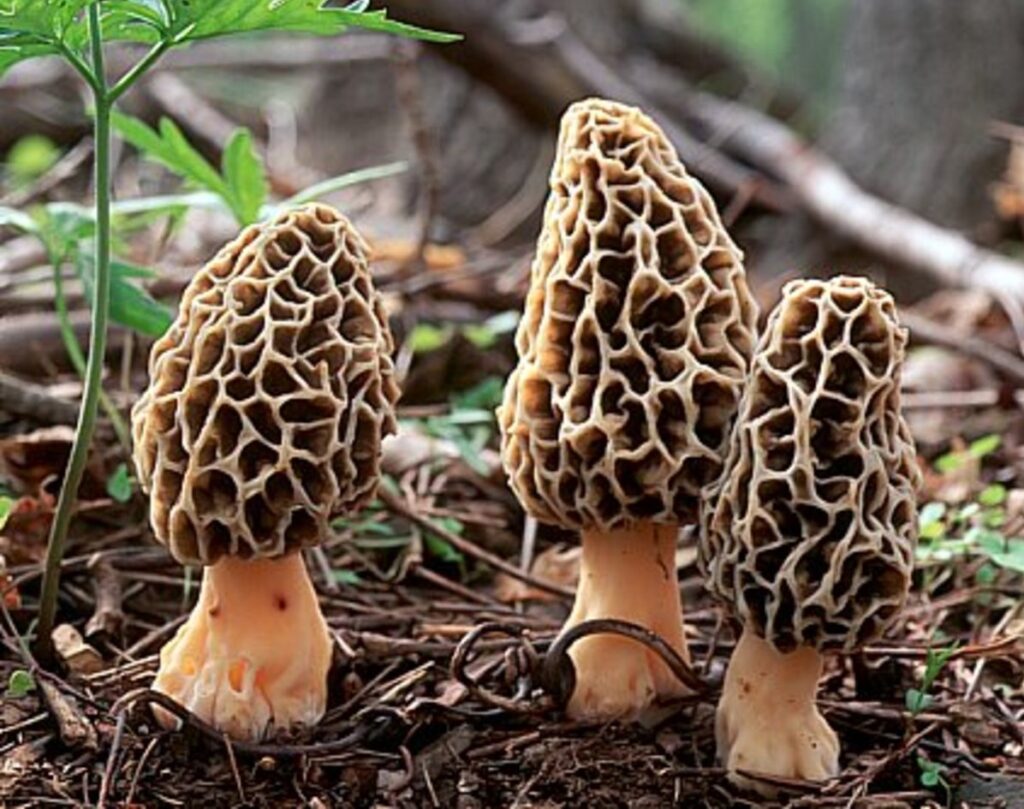
Morels are an extremely popular edible mushroom. They are perhaps the most sought after of all edible mushrooms in North America. They are delicious, unique in appearance, and easy to identify. This makes them an easy and popular choice for the beginner mushroom hunter. However, their season is very short in New England. In New England, We don’t have the luxury (and possible tragedy) of “Burn Morels”. Burn Morels pop up after wild fires and controlled burnings sometimes used in forest management in the North Western US. Here in the East however, we only see morels in the very early spring. They associate with a variety of different trees in a mutualistic relationship that benefits both the fungus and the tree, and they will usually come back every year at that same tree. But the short time period when they grow, makes them a rare treat. The wonderful flavor and short window of opportunity to find them, has made many morel hunters in New England protective of their favorite “hot spots”. So, if you’re lucky enough to find a spot that no one else has found. Be sure to come back next year to see if you can strike gold again.
Oyster Mushrooms

Oysters are one of my favorite mushrooms for several reasons. They are a relatively safe choice for a beginner. They’re fairly easy to identify, and there are very few harmful look-alikes. They often grow in abundance, and have a very long growing season. Oysters will grow almost all year long. It’s only in the deepest, coldest part of winter (January/February) that they will not grow. They are a saprophyte meaning you will find them on dead or fallen trees and logs. They grow in overlapping clusters, with a flat cap that sometimes can looked scalloped with age. The cap color can range from bight white to medium brown or blue gray. The underside of the cap will contain white gills that run all the way to base of the mushroom, where it connects to the wood it is growing on. It also will produce a white, lilac or light gray spore print. The only bad thing about oysters is that you have to be quick. They don’t stay fresh very long outdoors, especially in the hot summer months. But, that gives you a good reason to spend more time in the woods looking for them, and that in my opinion isn’t a really a bad thing.
Chicken of the Woods
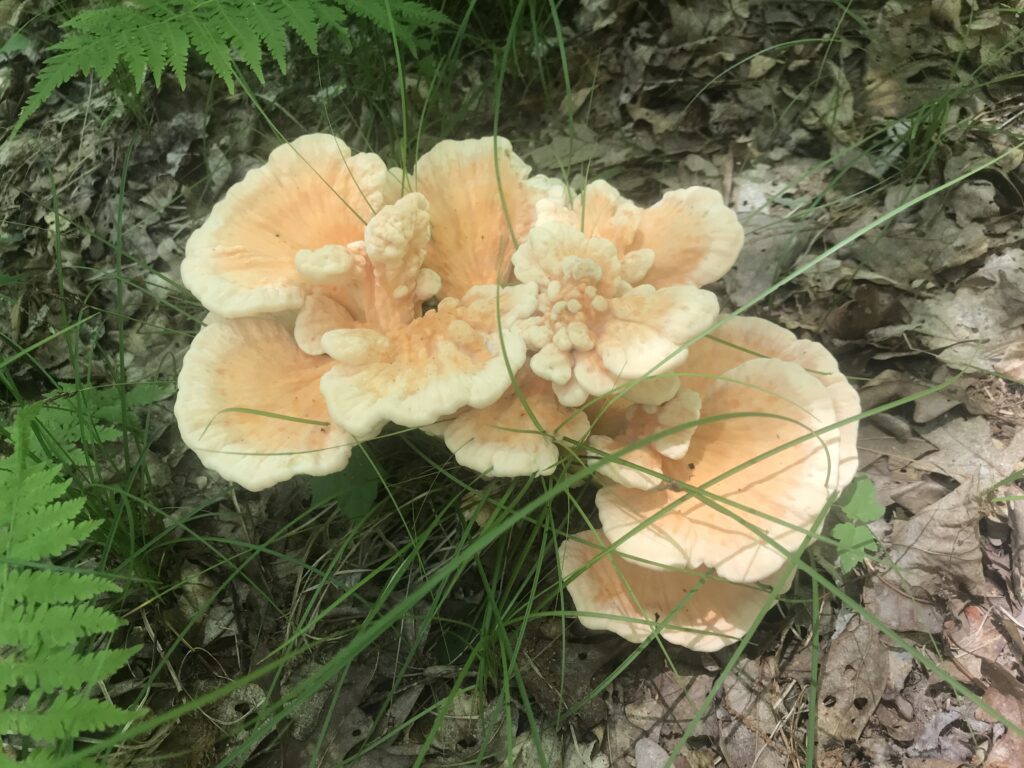
Chicken of the Woods is another great mushroom for beginner mushroom hunters. They grow in large bright orange clusters on dead or dying trees, and on fallen logs from spring to early autumn. They are very bright, so they can be easy to spot. However, they seem to always be hiding on the side of the tree/log that is facing away from the trail. Perhaps that because the bright color means the ones facing the trail have already been picked by other mushroom hunters. They grow either in an overlapping shelf like pattern on the side or a tree or log, or as a rosette if growing from the base or roots of a tree. The one pictured here is growing from the roots of a nearby oak tree. There are two varieties in Connecticut. One has a bright orange top, and yellow pores underneath the cap. The other has a lighter orange, peachy colored cap with a white pore surface. Both are mild flavored, and absorb the flavor of spices well, and have a texture similar to chicken (hence the name “chicken of the woods”).
Chanterelles
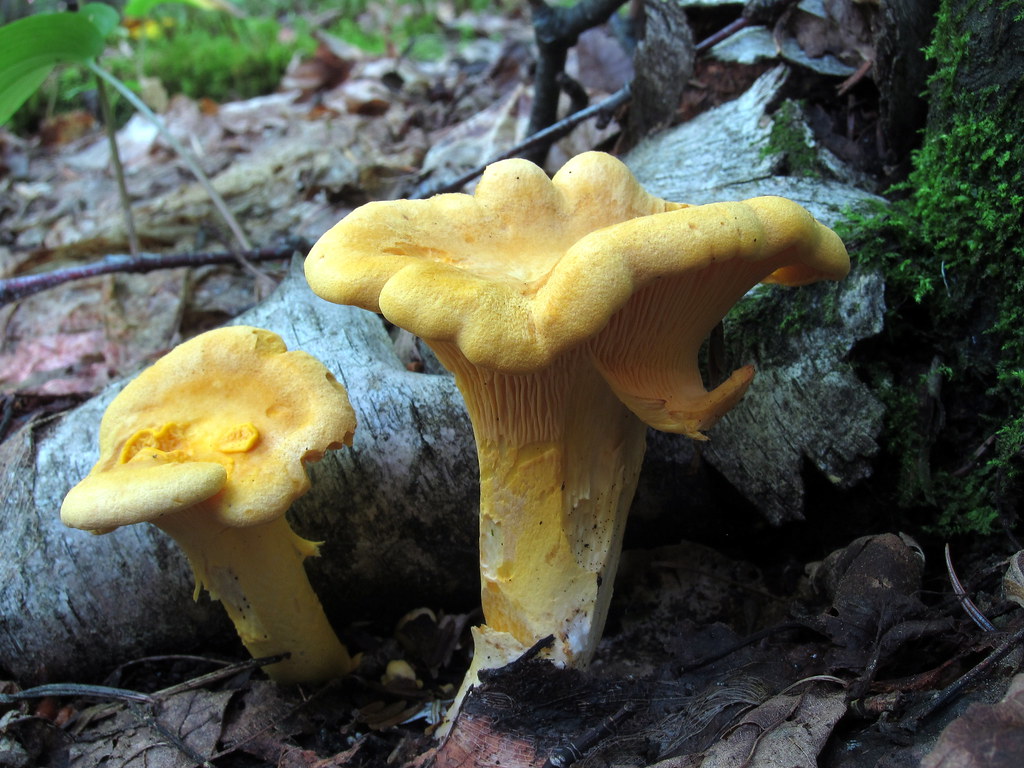
Chanterelles are another great beginner mushroom because they have a unique feature that sets them apart from many other potentially harmful mushrooms. That feature is the false gills which I will describe shortly. But first, Chanterelles are a summer mushroom They begin to pop up in late spring/early summer. They are a mycorrhizal mushroom, meaning that they associate with a host tree. They share nutrients and water with the host tree in a mutually beneficial relationship.
So, when looking for chanterelles, we first look for the trees they associate with. They associate mostly with coniferous trees such as Pine, Fir, Spruce & Hemlock. However they associate with Oak as well. They are medium sized and gold or yellow in color. They will be slightly vase shaped, often times with a wavy or scalloped cap margin. The gills will run from the underside of the cap part way down the stem. The gills themselves are not actually true gills. They’re more like raised ridges. These ridges will also branch and interconnect, often times giving them the appearance of veins. The inside of the stem will be white, and if pulled at, it should be come apart in strands similar to a piece of mozzarella string cheese. But, the taste, is much different. They smell fruity, and will retain that sweetness when cooked. Before I we move on to the next mushroom, I have to tell you about another type of Chanterelle in Connecticut, the Red or Orange Chanterelle. They share all of the same unique traits of the yellow variety, except they are quite small, and Red or Bright Orange in color. What they lack in size though they make up for in numbers, often growing in large groups with dozens to hundreds in a single small area. The other main difference is flavor. Instead of having the sweet fruity smell and flavor of the yellow chanterelle. The red chanterelle is peppery, and is great addition to omelets and fried dishes.
Black Trumpets
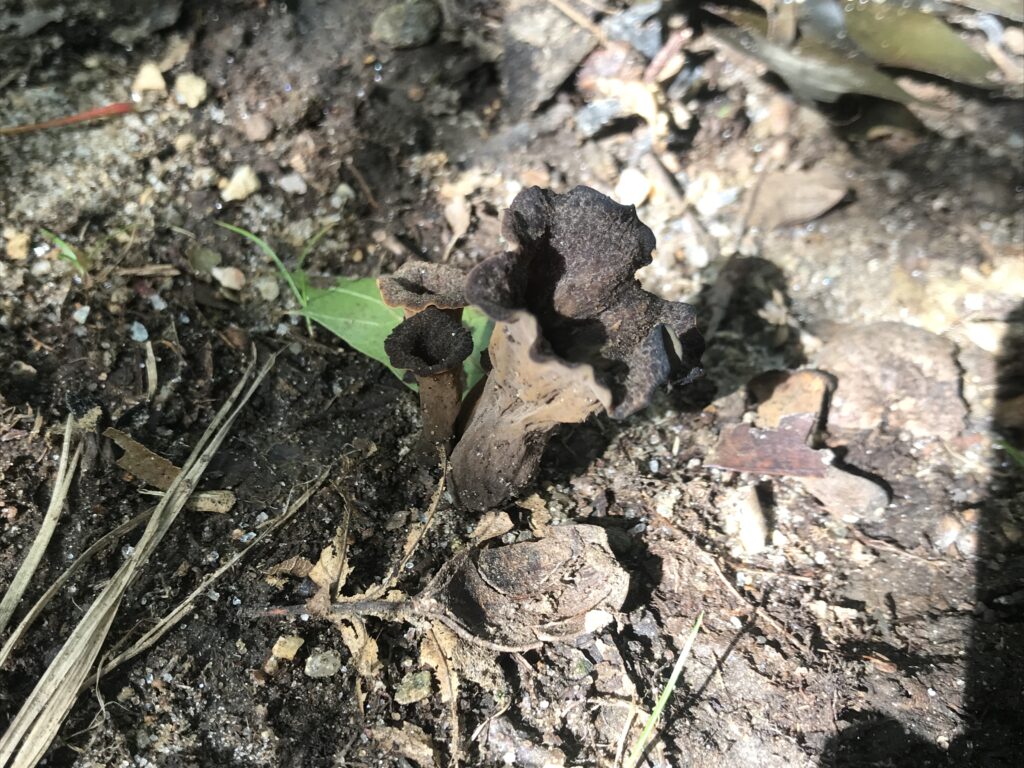
Black Trumpets look like something you wouldn’t want to pick up off the ground and put in your mouth. But I assure you they’re worth it. They grow in the fall and will stop as winter closes in. Supposedly they can grow in spring also, however I believe it’s a rare occurrence. I have never seen one in spring myself. I did find a few once in February, when there was a ‘fools spring’, we had small heat wave with plenty of rain. The area they were found had experienced some flooding. But, the best time to look is throughout fall. These mushrooms, like their relative the Chanterelle, are mycorrhizal. They can be found near Oak and Beech trees, as well as on moss patches. They can be very difficult to spot since they are so dark and wrinkly textured. They camouflage well in the decaying leaf litter, sticks and bark fragments on the forest floor. However, once you find one, it’s very likely that there will be more in the surrounding area. They seem to grow in little clusters of 1 to 4 mushrooms. It has no clearly defined cap or stem usually. It is shaped like a hollow vase with a wide and wavy shaped open top. The upper/inner surface is typically a darker black or dark gray as compared to the underside/outer surface which will be lighter in color. There are no gills or pores on either the inside or outside. But, the outer surface does produce light yellow spores, which is why the outer surface tends to look lighter than the upper/inside surface. The flesh is wrinkly but smooth, and somewhat brittle. The flavor is unique. “Mushroomy” but also slightly pungent and hearty. Delicious in mixed with rice with a white sauce.
Shaggy Mane
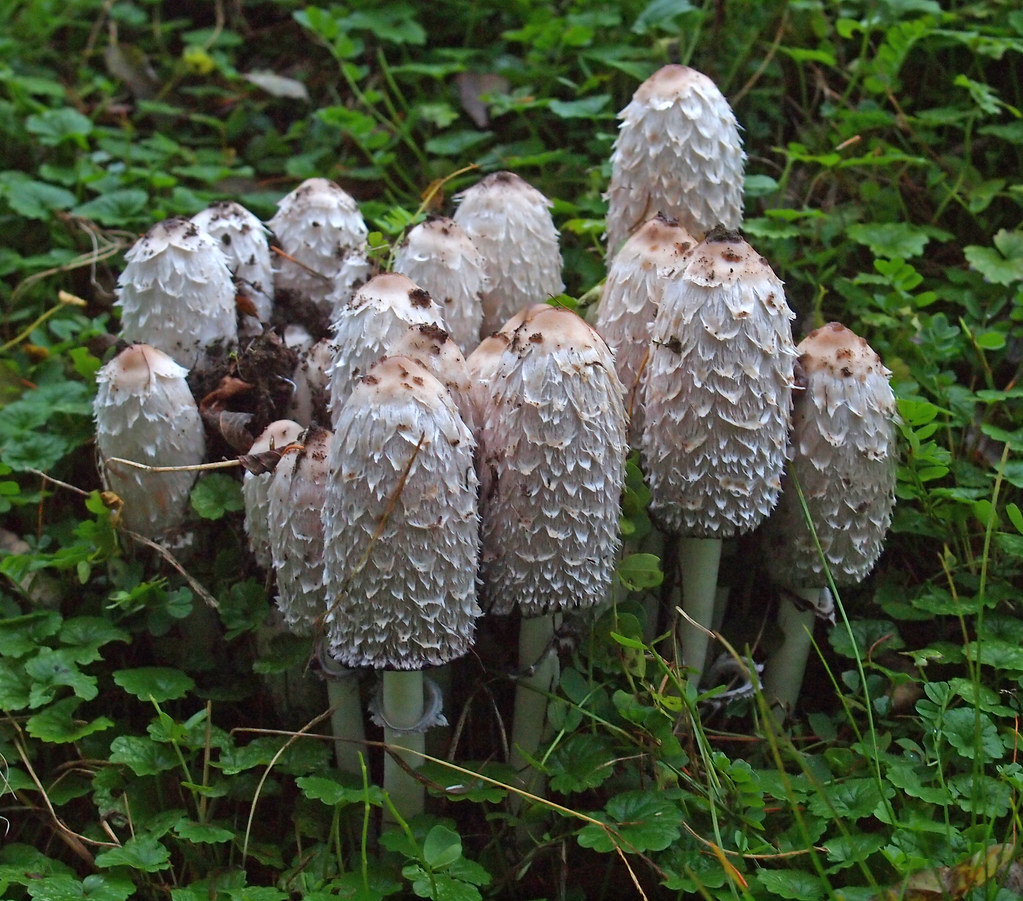
Shaggy Manes are an interesting mushroom. They belong to a group of mushrooms commonly known as “ink caps”. This is because as they age, the cap begins to curl up and melt into a black liquid which drips from the edges, reminiscent of ink. The process of the mushroom turning into the liquid goo is called “deliquescing”. These mushrooms seem to pop up in late summer and early autumn. They grow typically in grass, and are saprophytic. Which means they are decomposing dead plant material just below the surface. They grow typically near the edges of fields. Sometimes out in open field, but more often near the edges of the areas of grass, near landscaping, tree lines, walking paths, driveways, etc. Anywhere the grass meets a boundary. They have a long bullet shaped cap with long curling fringe, or scales coming down in row on the surface of it’s white cap. The very top of the cap may sometimes be a light brown color. But overall the mushroom will be white. Underneath the cap are gills, but they are rarely visible unless the mushroom has already began to deliquesce. In which case you won’t want to take it home to eat. The stem is also white, hollow down the center, and usually covered in fine white grainy powder on the outside. They sometimes grow singly but more often you will see several individuals growing in a group. You can be extra sure you have found the right thing if some of the older ones are starting to curl up and drip their black ink. Their flavor is mild but distinct. If you eat any other species of “ink caps” in the future, you will be able to taste that they are related.
Hen of the Woods

Hen of the woods are one of my favorite edible mushrooms because with just one mushroom, you often times can make several meals. The last one I found, made three meals, and I still had a gallon Zip-lock bag of dehydrated mushroom left over for future meals. All that from just one mushroom. You would think with such a large size, they would be easy to spot. But, that’s not necessarily the case, because of their color and texture. They grow from fall to early winter. When most of the green has left the forest, and various shades of brown dominate the forest floor. The fungus is a parasitic on a host tree and causes butt rot, which may eventually kill the tree. Host trees are typically Oak, but it can infect other broad leafed trees as well. It grows in a large rosette shape, with sizes of one foot or more in diameter being a relatively common. They will be found close to the base of the tree they are infecting. The cap consists of multiple smaller overlapping fans with a brown or gray upper surface, which makes it blend in well with the forest floor. The underside of the caps are white and covered in a multitude of tiny pores from which it’s spores will be released. It’s texture and abundance makes it a great meat substitute. My personal favorite is “Hen” Stroganoff. All those tiny pores are like little straws drinking up the flavor of the spices it’s cooked with.
Puffballs
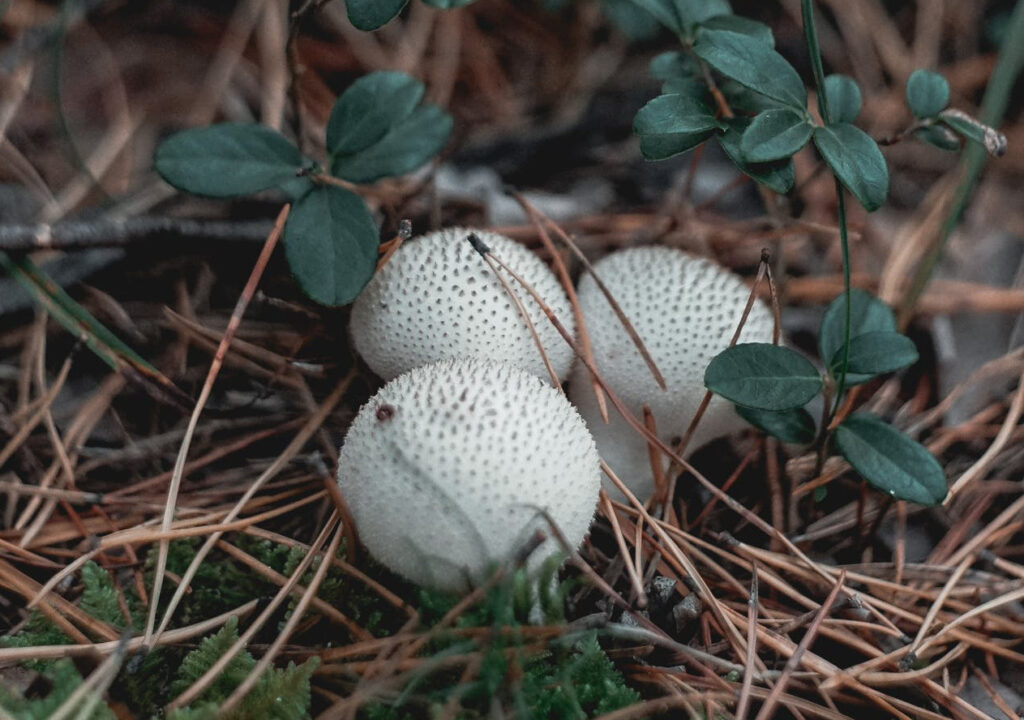
I almost didn’t include puffballs in this list because they don’t fit neatly in a box. All the other entries on this list consist of either a specific species, or species within the same genera. But, “puffball” is more of a catch all term for any round mushrooms that are filled with spores. Some grow in grass, some grow in the forest, and some grow on wood. I haven’t prioritized hunting them personally, and I have yet to find one of the popular giant puffballs. Fortunately, while there are many varieties of puffballs, there is one common rule when determining edibility. The edible ones, when cut in half, will be a consistent solid texture that is firm and pure white in color. The color black or purple one the inside indicates toxicity. Any other discoloration would indicate that it’s too old to be eaten and could cause stomach update. But most important of all, is that you are able to determine that is not an Amanita “egg”. The Amanita family of mushrooms contains deadly poisonous species. When young, those mushrooms are contained within a ball shaped “egg”. Cutting the egg down the center from the top to the bottom will reveal the profile of a young mushroom inside. Those are NOT puffballs, and eating them could be a deadly mistake. However, It should be easy to discern between a puffball and a potentially deadly amanita “egg” if you are careful, do your due diligence, and make sure you cut your puffball in half vertically. As always, be sure to cite multiple references and seek out help if you are not 100% sure of what you have found. When in doubt.. Throw it out!
Hedgehog

Hedgehogs have another common name, and that’s “sweet tooth”. The “Tooth” part of the name refers to the spines underneath the cap, and the “Sweet” part refers to it’s fruity and sweet scent. They grow from early fall until winter begins to take hold. They grow near hardwoods along the edges of rivers and areas where there is high humidity but ample sunlight. There will usually be lots of moss growing in areas where hedgehogs can be found. In the east, our hedgehogs associate with Oak and other broad leaf trees. The cap is typically a orange/peach or pinkish on top and the stem is white. Typically it’s a small to medium sized mushroom, sometimes similar in overall shape to the Chanterelle. However, the underside is covered in white spines or teeth. It’s odor as mentioned before is sweet and fruity, and is often said to be reminiscent of apricots. The combination of its color, toothed underside and scent should be enough to help identify this mushroom in the wild. There are actually several different species of Hedgehogs in New England, some lighter colored, some more orange in color. Some shorter and stouter, some taller and more flat capped. But they are all edible and share the traits mentioned above. It’s flavor when cooked is sweet, nutty, and similar to Chanterelles.
Lions Mane
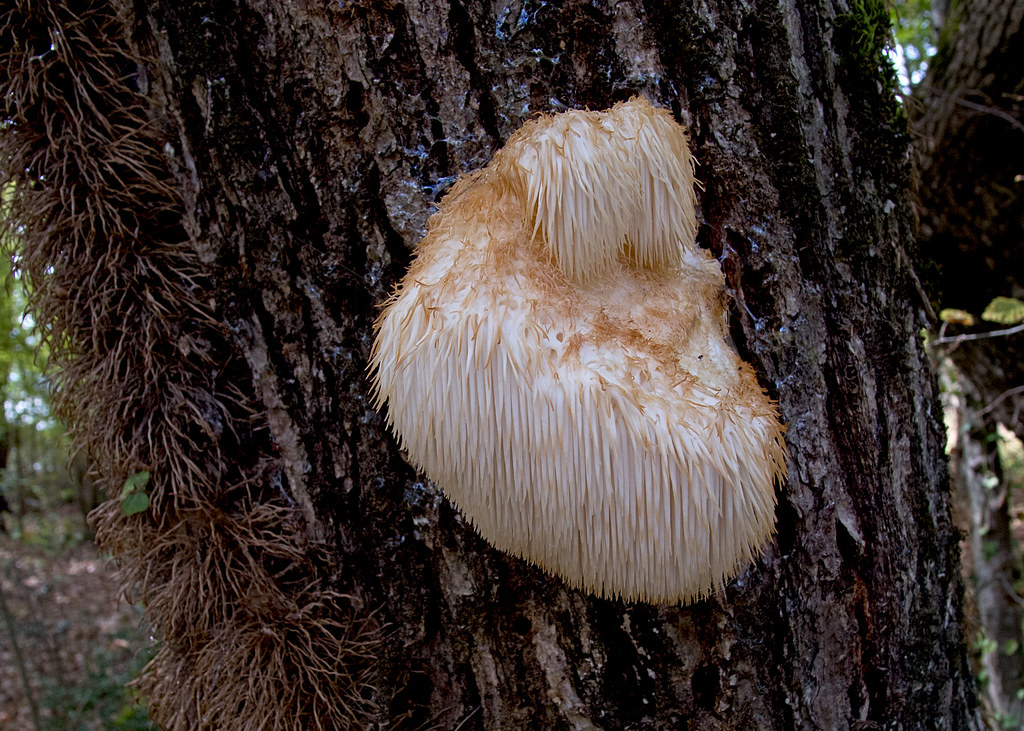
Lions Mane is another very unique mushroom. You might look at it and think. “Is this even a mushroom?” But yes, It’s a very unique mushroom. They grow in the colder months of the year. After Halloween is probably the best time to start looking for them. They grow on dead, dying, or fallen wood. They often times grow on the wounds of still standing trees, or freshly cut or falling ones. They can standout a little against the brown tones of the forest. The grow on hardwoods, primarily Oak. It doesn’t take much skill to identify a big white lump with a bunch of long flowing spines on it cascading down like a waterfall. As it ages the spines will begin to turn brown. The inside is also white and does not bruise when cut. There are a few other varieties whose underlying structure is less ball like and has some branching stems which are also covered in these long flowing spines. The only thing that might look similar that is not Lions Mane relative, is an immature northern tooth fungus, but those have move of a shelf like appearance, with spines only on the under side of the cap. When cooked, it’s soft and juicy, and makes great meat substitute. The flavor is somewhat reminiscent of seafood, and is often said to taste like crab meat. Lions Mane Crab Cakes are a popular recipe for this wild mushroom.
That concludes our top ten edible mushrooms for beginners. There were a lot of other contenders for this list. Like the Green Cracking Russula, and a number of species of Suillus and Bolete relatives. But, I tried to keep this list to only the safest and most common mushrooms out there. The same ones I first learned about, and foraged. I hope you enjoyed this list and come back to it often as you learn more about mushroom foraging. Remember to cite multiple sources and do your own research before eating any mushroom. Always be 100% of what you are eating, or it may cost you your life. When it doubt. Throw it out!!